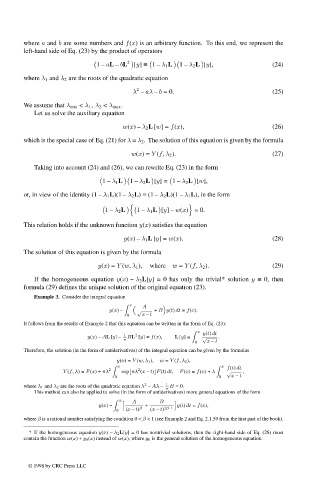Page 490 - Handbook Of Integral Equations
P. 490
where a and b are some numbers and f(x) is an arbitrary function. To this end, we represent the
left-hand side of Eq. (23) by the product of operators
2
1 – aL – bL [y] ≡ 1 – λ 1 L 1 – λ 2 L [y], (24)
where λ 1 and λ 2 are the roots of the quadratic equation
2
λ – aλ – b = 0. (25)
We assume that λ min < λ 1 , λ 2 < λ max .
Let us solve the auxiliary equation
w(x) – λ 2 L [w]= f(x), (26)
which is the special case of Eq. (21) for λ = λ 2 . The solution of this equation is given by the formula
w(x)= Y (f, λ 2 ). (27)
Taking into account (24) and (26), we can rewrite Eq. (23) in the form
1 – λ 1 L 1 – λ 2 L [y]= 1 – λ 2 L [w],
or, in view of the identity (1 – λ 1 L)(1 – λ 2 L) ≡ (1 – λ 2 L)(1 – λ 1 L), in the form
1 – λ 2 L 1 – λ 1 L [y] – w(x) =0.
This relation holds if the unknown function y(x) satisfies the equation
y(x) – λ 1 L [y]= w(x). (28)
The solution of this equation is given by the formula
y(x)= Y (w, λ 1 ), where w = Y (f, λ 2 ). (29)
If the homogeneous equation y(x) – λ 2 L[y] = 0 has only the trivial* solution y ≡ 0, then
formula (29) defines the unique solution of the original equation (23).
Example 3. Consider the integral equation
x A
y(x) – √ + B y(t) dt = f(x).
0 x – t
It follows from the results of Example 2 that this equation can be written in the form of Eq. (23):
x y(t) dt
2
y(x) – AL [y] – 1 BL [y]= f(x), L [y] ≡ √ .
π x – t
0
Therefore, the solution (in the form of antiderivatives) of the integral equation can be given by the formulas
y(x)= Y (w, λ 1 ), w = Y (f, λ 2 ),
x x f(t) dt
2
Y (f, λ)= F(x)+ πλ 2 exp πλ (x – t) F(t) dt, F(x)= f(x)+ λ √ ,
0 0 x – t
2
where λ 1 and λ 2 are the roots of the quadratic equation λ – Aλ – 1 B =0.
π
This method can also be applied to solve (in the form of antiderivatives) more general equations of the form
x A B
y(x) – β + 2β–1 y(t) dt = f(x),
0 (x – t) (x – t)
where β is a rational number satisfying the condition 0 < β < 1 (see Example 2 and Eq. 2.1.59 from the first part of the book).
* If the homogeneous equation y(x) – λ 2 L[y] = 0 has nontrivial solutions, then the right-hand side of Eq. (28) must
contain the function w(x)+ y 0 (x) instead of w(x), where y 0 is the general solution of the homogeneous equation.
© 1998 by CRC Press LLC
© 1998 by CRC Press LLC
Page 472

